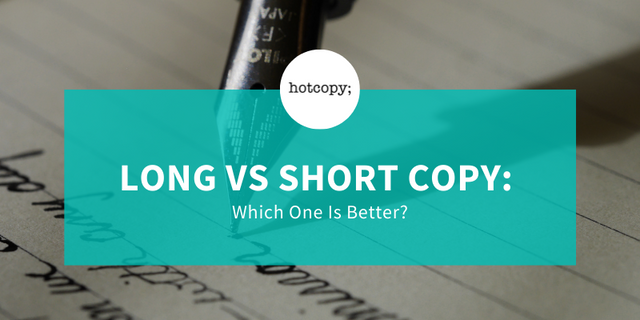Long vs Short Copy: Which One Is Better?

Are you aiming to create content for high engagement? One of the factors to consider is the length of your post. How many words are ideal when writing for your website?
If you’re going to look at the latest content marketing statistics, you will see that search engines favor longer content more than short ones. A report by SEMrush suggests that articles with over 3,000 words get three times more traffic.
Not only do long articles rank higher on search engines, but they garner more backlinks too, according to a study by Moz. But in writing SEO-friendly content, it’s not just enough to rely on what Google or other search engines prefer.
Remember, around 90% of the Asian population use a smartphone. But who would want to scroll through a 10,000-word piece on a small screen?
Understanding Blog Post Length
Long copies are content with around 1,000-7,000 words on average. The main goal of creating long-form content is to give valuable information to your readers. You often see it in authoritative blog posts or content with an in-depth analysis of a certain topic.
Short copies, on the other hand, are usually written to give a simple definition or provide a quick answer to your readers’ questions. Short-form content examples are social media posts like tweets and Facebook updates. Other short-form content examples include bite-sized, listicles, and short blogs.
Copywriting pros, like Bob Bly and Joe Sugarman, believe there are rules to follow when deciding to write a short copy or a longer one. According to Bly, the length of a copy should depend on the product you’re writing for, your audience, and your purpose for writing.
Sugarman, the author of “Advertising Secrets of the Written Word,” suggests one has to look at the price point and the kind of item when writing a copy.
For example, if you’re going to write a technical article for a newly launched device, you would want to come up with long content to help readers figure it out.
To help you decide between using long-form vs short-form content for your next blog post, we've put together a comprehensive list for you.
Here are the advantages and disadvantages of both and when to use them.
Pros and Cons of Long Copy
Advantages
- It allows you to cover a topic in an in-depth manner. Long-form content works well with topics that provoke thought and discussion. If you’re covering a complex topic, 500 words may not be enough to explain it well.
- It helps improve your website’s reputation. Going back to Moz’s study about backlinks, it’s worth knowing that authoritative and trustworthy websites have a higher chance of landing on top of search engines’ results. When other websites vouch for your content, it signals Google that your content is worthy. It's like Google's way of rewarding websites with a good reputation.
- Long content helps you build a better relationship with your audience. When writing for a product/service that involves making a big decision for your reader, longer copies may be more effective than shorter ones. Long copies work well when working with new and expensive products/services.
Disadvantages
- It can distract your readers from taking action. A rule of thumb when writing a post is to supply as much information as needed. That does not necessarily mean you have to add more words. If your goal is to get your readers to take action, simply get straight to the point.
- It can get boring. When a page is filled with a block of text, readers will most likely leave or find answers elsewhere. Avoid writing long paragraphs because they may be hard to read. Keep your sentences short to make them more skimmable.
How to Write Long-Form Content
- Start by brainstorming your ideas. Before writing your copy, it helps to know what your target audience prefers. Remember, writing for younger generations requires a different approach compared to writing for the older ones. For instance, millennials have shorter attention spans, and while they do enjoy reading, their average attention span is only eight seconds.
- Write your draft. An outline can help you organize your ideas. Since you’re working with a lengthy post, you might want to divide your task into segments or take a break when writing. To be better at editing your own work, you might need to let it rest for a while and go back to editing after a break.
- Revise and reorder your content. One of the best editing tips is to read your text aloud. Reading it aloud lets you know the rhythm of your writing. Remove wishy-washy sentences and omit repetitive phrases. When possible, get feedback for writing. Use an editing app such as Grammarly or Hemingway app to help you write faster.
Pros and Cons of Short Copy
There are instances when short content is better. Think of yourself as the reader. Do you have time to read it word for word? This depends on the topic.
If it’s interesting enough for them, your readers will even stop what they’re doing to read your entire post. But if the topic does not interest your target audience, they will not read it no matter how good it is. As the adage goes, less is more.
Take a look at the pros and cons of creating short copies.
Advantages
- You can get it done even with limited time and resources. As a writer, this means less time doing your research and brainstorming ideas. If you believe your product or service is simple or needs little explaining, writing short copies are the best way to go.
- It’s easy to consume for readers. Your blog post does not need to be perfectly written. Instead, it should be easy to digest for your target audience. One way to make your content digestible is to create a format that is easy to read, like in the form of lists or bullets.
- It’s ideal for users who only skim information. Remember, not all readers will enjoy reading a long copy. Most readers only skim or read the main ideas within a passage. According to the Nielsen Norman Group, around 80% of people do skim-read online content to get a general idea of its meaning.
Disadvantages
- It may not be persuasive enough. Sometimes, when content is too short and does not provide sufficient information, your reader may not be convinced to click on a website or buy a product.
- All your readers’ questions may not be answered. Without supplementing them with enough information about your product/service, your readers may have anxiety about it especially if it’s a new product.
Conclusion
Length is just one factor when creating content for high engagement. More than the number of words, SEO-friendly content needs to have useful information and compelling headlines.
When you’re having a hard time deciding between long-form vs short-form content, always consider your audience and the type of service/product you’re writing for.
What matters more than the length is the depth of an article. You can write a long copy and get the best results for your business. Likewise, you can write a short one and get your readers to take action.
Photo by Free-Photos / 9089 images on pixabay
Want to save time and money on the content for your brand?
Try our hotcopy; AI platform to optimize your content production workflow today.
The first few words are free for you to try.


